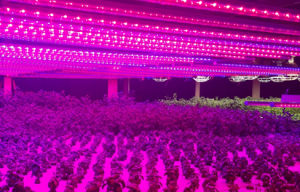- 36 reads

To date, business and property owners have primarily used Light Emitting Diode (LED) technology to reduce electricity costs for building illumination. New generations of LED lights now have the capability to cost-effectively grow vegetables. One company, Independence LED Lighting, has taken the LED grow lights to a new level, and they are also starting to offer programs for high schools and colleges. Their education vision focuses on the goal to reduce the farm to table distance from hundreds of miles to hundreds of feet. They hope to feed students fresh, organic vegetables that are grown on campus by the students through state of the art lighting, while simultaneously teaching Science, Technology, Engineering and Math (STEM) along the growth process.
See more here on the Independence LED Grow Lights.
Charlie Szoradi, the CEO of Independence LED Lighting said, “We see a win/win for schools to transfer the money that they are already spending on vegetables toward on campus LED grow operations that have the added benefit of acting as laboratories for agriculture and STEM education.”
Independence LED has identified several challenges that create this opportunity:
- Global population has doubled to over 7 billion since the first Earth Day in 1970.
- Human activity may deplete fresh water resources before depletion of fossil fuels.
- In America, food often travels hundreds of miles or more to its destination in many areas.
- America faces increasing health challenges from childhood obesity and an overweight population.
- Low-income households are at the highest risk, given limited access to affordable fresh produce.
- The developing world faces increasing food challenges, given droughts and extreme weather.
Indoor agricultural systems with Independence LED lights, allow for many different aspects of plant production study within Greenhouses as well as Aquaponic, Hydroponic, or Aeroponic systems. The majority of the earth’s crops have had between 12 and 16 hours of sunlight to grow for thousands of years, but this does that necessarily mean that mimicking that same single period of light will always produce the best yield. Schools that adopt this new technology can participate in research as they literally eat the output of their experimentation. The testing may include multiple illumination run time scenarios with smart controls.
Sample Experimentation:
Dimming as lights turn on and off to mimic sunrise and sunset
16 hours on, and then dimming to reduced output levels for 8 hours
8 hours on, 8 hours off, 8 hours on, for 16 hours of light per day
40 minutes on, 20 minutes off, repeated over 24 hours for 16 hours of light per day
4 hours on, 4 hours off, 4 hours on, 4 hours off, 4 yours on, for 12 hours of light per day
Testing opportunities are countless for all sorts of leafy greens and vegetables across these conditions and more.
Perhaps students will use this new LED technology to discover some previously unknown aspects of photosynthetic optimization that will help advance the global food supply chain and foster sustainability.

